Matador Network's Blog, page 11
September 12, 2025
Spookiest State in the US? Nevada Issues New ‘paranormal Passports.’

If you’ve ever been on a road trip but thought “there just aren’t enough ghosts around here,” one state may have a suggestion for you. Nevada just announced an expanded and extended investment into its creepy side, with free “Paranormal Passports” available to visitors of the Silver State. Like a real passport, stamps are available at multiple gateways and visitor hotspots. But unlike a real passport, where filling your pages with stamps means a lengthy replacement process, Nevada Paranormal Passport holders who collect stamps will instead win road-trip-ready prizes (if they survive visiting all the spooky destinations, of course).
The Paranormal Passport first launched in 2023 as a response to the rising interest in odd, offbeat, historic, and generally less-crowded tourist sites, which thrived while people were “social distancing” during the COVID-19 pandemic. While Nevada saw 56 million visitors in 2024, the vast majority were to Las Vegas. Nevada is one of the least densely populated states in the country, with only about 30 people per square mile, compared to more than 250 in California. So as soon as you get beyond the neon lights of Vegas, there’s a good chance you’ll have lots of space to yourself. That’s ideal for roadtripping, and if you ask paranormal experts, ideal for everything from UFO sightings to mysterious creatures that go bump in the night.

Photo: Travel Nevada
Visitors can get their own free Paranormal Passport from the official website, which maps out more than 50 haunted, historic, and downright mysterious attractions across Nevada. Stops range from the infamous Clown Motel to old mining town saloons still slinging beer in historic Virginia City. After signing up, a passport link will be automatically texted to users, allowing them to access their passport at any time without needing to download an app. It acts like a digital checklist, where checking in with GPS at participating sites earns users a stamp. Collect enough stamps, and you can redeem it for Nevada-themed swag like tote bags and Rumpl blankets.

Photo: Travel Nevada
Nevada’s reputation as a paranormal hotspot stems primarily from its mining history. Towns that saw rapid growth overnight during silver or gold rushes had saloons, hotels, and theaters, but also accidents, violence, and epidemics. When these towns’ mines dried up, many left in a hurry, leaving behind crumbling buildings, hastily built cemeteries and, in some cases, even personal possessions. It’s hard to visit the state’s ghost towns and not feel something a little eerie, especially if you’re the only one there.
Nevada’s geography also plays a role, as much of the state is sweeping, quiet desert. When road tripping, you’ll encounter long stretches of empty highways, abandoned shacks, and plenty of tumbleweeds. It makes some places feel extra removed from civilization, and in places like that, it’s hard to not overthink things when you hear an unexplained sound or see lights in the distance.
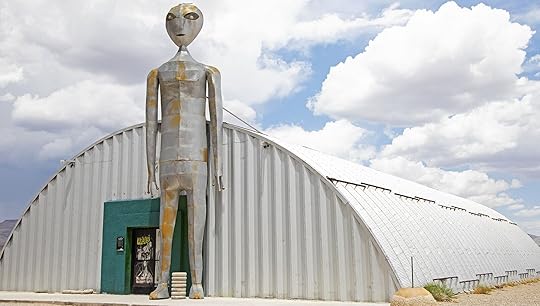
Photo: Travel Nevada
Layered on top of the state’s Gold Rush history and empty places are Nevada’s ties to extraterrestrial stories. Area 51 and the “Extraterrestrial Highway” have become international symbols of government secrecy and ground zero for speculation that the US Government is covering up knowledge of alien visitation. Throw in Nevada’s few top-secret military testing sites, and it’s no wonder the state is known for everything from ghosts to aliens to unexplained desert phenomena.

Tarrytown Music Hall in New York. Photo: Adam McCullough/Shutterstock
Nevada has some of the most mysterious places in the US, but it’s not the only state welcoming visitors to take a look at its creepier side. You’ll find similar offerings on New York’s Haunted History Trail, which includes more than 80 stops, or West Virginia’s Paranormal Trail, which includes sites like the Mothman Museum and cryptid-themed mini golf. Other states, like Kentucky, may not have official themed routes, but have plenty of information on their tourism websites about where to find the creepiest locations in the state. Travelers who have only a day or evening to devote to paranormal activity will likely find ghost and history tours in most major cities throughout the US, from Chicago and New Orleans to San Francisco and Orlando. 
September 11, 2025
This Retro Car Museum in Wyoming Doubles as a Unique Place to Stay

Located on Interstate 90 between Big Horn National Forest and the Black Hills, the small town of Gillette is a convenient stopover on a Wyoming road trip. And convenience gets a revamp with the opening of four unique accommodations that go above and beyond the typical motel stay. These self-contained vacation rentals are under the management of the Frontier Auto Museum and Cafe in Gillette, Wyoming. Owned by the Wandlers, this kooky attraction – part family heirloom, part passion project – is much more than cars.
We hope you love the Frontier Auto Museum! Just so you know, Matador may collect a small commission from the links on this page if you decide to book a stay.
What to know about the Frontier Auto Museum in Gillette, Wyoming
Photo courtesy Frontier Auto Museum
Classic automobiles, restored gas pumps, vintage apparel, retro gadgets, and neon signs galore: the Frontier Auto Museum is a treasure trove of North American nostalgia which started as a hobby between father and son and blossomed into a fully-fledged family business.
After moving to Gillette in the 1960s, Leon Wandler began collecting Hudsons from auctions which his son, Jeff, gradually came to take an interest in. This developed into a shared enthusiasm for restoring classic cars and gas pumps as well as acquiring dealership signs, which continued until Leon’s passing in 2004. After hearing that the compound intended for the Ford dealership in the 1940s was up for sale, Jeff leapt at the opportunity to open a museum in memory of his dad.
Jeff now manages the Frontier Auto Museum alongside his wife, Tammy, their daughter, Briona Brewer, and her husband, BJ Brewer. Spanning 13,000 square feet, the museum is divided into nine showrooms containing artefacts tracing everything from engineering to fashion throughout the 20th century. It all starts “Downtown” with a 1923 Ford Model T parked beside the recreation of a Frontier Gas Station. A 1929 Coupe, a 1947 pickup truck, and a 1949 Commodore convertible are also contained within the collection. Most of Leon’s Hudsons are on display in the Sinclair Room, where the limelight is almost stolen by a dinosaur who has starred in multiple world fairs.
Besides the classic car displays, the Wyoming Motel installation touts lovingly restored neon signage alongside a retired phone booth and coin-operated radio. There’s a department store stacked to the gills with vintage clothing whereas Kerk’s Barbershop recreates a typical cutting salon using items procured from a salon in Nebraska. Despite dating back to the 1930s, this space is still used for styling experiences during special events. Last but not least, there are hundreds, possibly thousands, of neon signs scattered throughout the premises. Among these are 300 original Sinclair globes, Hudson dealership neons, and a drive-in theater sign acquired from Laramie, Wyoming.
The Frontier Auto Museum is open Monday to Friday, 09:00 AM-05:00 PM. Admission is $14 per person with concessions available to veterans and students. Children under six go for free. The Commodore Cafe, modeled on a soda shop, serves comfort fodder and milkshakes in a themed setting.
Unique Airbnb lodging near the Frontier Auto Museum in Gillette, Wyoming
Photo: Airbnb
Wandler and Brewer manage four Airbnb properties attached to the Frontier Auto Museum. These self-catered vacation units are ideal for couples and families seeking additional space and the creature comforts often lacking in roadside motels.
The Cottage – this is a cozy one-bedroom house with a fenced backyard and spa features. An assortment of 1950s furniture creates a homely charm while the hot tub and sauna add a touch of luxury to an overnighter in Gillette. One additional guest may sleep on the couch in the lounge.
The Carriage House – designed with a Western touch, this studio is another option for couples or small groups of up to three. This studio stands above the garage and has a fully-equipped kitchen and outdoor seating, shared with the Carter House unit. Kids and cowboy enthusiasts of all ages will appreciate the horsey decor.
The Carter House – this 100-year-old, castle-inspired rental has three bedrooms, two bathrooms, and a roomy kitchen and lounge. These three levels are linked by a spiral staircase while a backyard and rooftop with a fire pit provide additional living space. The maximum occupancy is seven guests.
The Ross House – the largest rental available at the museum, this 1930s Craftsman residence has four bedrooms accommodating a total of nine guests. This property is a match made in heaven for travelers who enjoy home comforts from the road. There’s a huge kitchen with a dual oven, granite countertops, and an island plus ample seating indoors and in the backyard. This green oasis is edged by cottonwood trees and has a lawn where the kids can play.
All four lodgings are furnished with antiques, luxury towels and bedding, cookware, smart TVs, and Wi-Fi. Free parking is available for all units.
What to see and do near Gillette, Wyoming
Photo: amadeustx /Shutterstock
As a hub for coal, oil, and natural gas production, Gillette, WY, is considered the Energy Capital of the United States and a gateway to the state’s prairie lands. Main Street is the heart of the community, preserving independent stores and being the center place for seasonal events.
Beyond the Frontier Auto Museum, Gillette, WY, is just an hour’s drive from Devil’s Tower. Designated America’s first national monument by President Roosevelt in 1906, this sacred monument carries a spiritual significance for Indigenous communities. Gentle hiking trails skirt their way through the plains and bring you closer to the natural wonder, and rock climbing is another option. Staying locally means you can catch a sunrise at the monument or stick around for sunset.
The Thunder Basin National Grassland stands 70 miles southeast of Gillette. This “big country” prairie is the habitat of ground squirrels, pronghorn antelope, mule deer, coyotes, swift foxes, and over 100 bird species. Infrastructure is fairly rudimentary, although the U.S. Forest Service does manage a series of hiking and backcountry trails focused on wildlife watching and photography.
One of North America’s largest and most respected family-owned bison operations, the Durham Bison Ranch, is 30 miles south of Gillette. This 55,000-acre working ranch runs summer tours around the corrals and grasslands, offering insights into bison behavior and local biodiversity. 
This West Virginia Road Trip Stops at the State’s Most Haunted Places

Spooky season is knocking on the door — and West Virginia wants you to drop your comforting pumpkin spice latte for a tour of the state’s freakiest locations. Launched in 2024, the state’s Paranormal Trail links 21 eerie stops into one epic, choose-your-own-adventure road trip. The route weaves together haunted history, ghost lore, and small-town charm into an unforgettable experience where you can check in at paranormal hotspots with a free digital passport and earn prizes along the way.
Last fall, the Paranormal Trail attracted travelers from 45 states and four countries — including Canada, the UK, Germany, and Australia — who explored haunted landmarks across West Virginia and redeemed more than 2,000 prizes. West Virginia’s tourism secretary, Chelsea Ruby, tells Matador Network the response revealed just how strong the appetite is for spooky travel, adding that the department is eager to build on that success with new locations and fresh prizes for 2025.
How the Paranormal Trail works
Photo: West Virginia Department of Tourism
So what can you expect this year? To get started, sign up online for a free digital passport that tracks your progress. The official site also has an interactive map to help plan your route and find nearby paranormal points of interest. Expect a mix of playful cryptid lore and genuinely unsettling locations — from lantern-lit ghost walks to the infamous Trans-Allegheny Lunatic Asylum in Weston, often called one of the scariest places in the country. Whether it’s haunted theaters or subterranean caverns, you’ll uncover some of West Virginia’s most fascinating and eerie legends.
What you’ll find along the routeThe itinerary winds through the state, connecting under-the-radar towns with some of West Virginia’s most iconic sites. It covers everything from river towns like Harpers Ferry to mountain communities in Mercer County, offering an itinerary that spans the state’s geography.
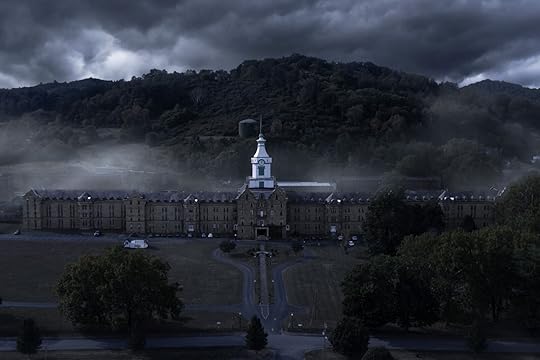
Photo: West Virginia Department of Tourism
In Weston, the Trans-Allegheny Lunatic Asylum is often considered one of the most haunted buildings in America. The psychiatric hospital opened in the 1860s and once housed thousands of patients. Though it closed in the 1990s, tours today explore both its medical past and the ghost stories tied to the building. People report unexplained sounds, flickering lights, and even encounters with the spirit of a young girl named Lily who’s rumored to still play inside.

Photo: West Virginia Department of Tourism
Farther north in Moundsville, the West Virginia Penitentiary is a Gothic-style prison that opened in 1876 and remained in operation for more than a century. It housed some of the state’s most violent inmates, experienced riots and executions, and earned a brutal reputation before shutting down in 1995. Now open to the public, the site draws paranormal investigators and curious travelers alike. Many claim to have seen a shadowy, human-like figure known as the “Shadow Man” lurking in the old cell blocks.

Photo: West Virginia Department of Tourism
In Mercer County, the Lake Shawnee Abandoned Amusement Park looks like it was plucked straight from a horror movie. Built in the 1920s on land with a violent past dating back to settler-Indigenous conflict, the park saw several tragic accidents — including the deaths of two children — before closing in the 1960s. Today, rusting swings and a Ferris wheel overtaken by weeds remain. The grounds are often described as unnaturally still, with some visitors reporting hearing laughter or glimpses of figures near the rides.
Not every stop on the trail is steeped in tragedy. In Lewisburg, Carnegie Hall still hosts performances — and maybe a few ghosts backstage. Cathy Rennard, president and CEO of the historic venue, tells Matador Network that staff have grown used to doors slamming after hours and elevators running with no one inside. At 123 years old, it’s worth visiting as much for its architectural beauty as for the ghost stories.
In Shepherdstown — the oldest town in West Virginia — the Shepherdstown Mystery Walk leads guests through haunted cemeteries and historic streets. Janet Huges, owner of the award-winning ghost tour, shares with Matador Network via email that visitors often leave talking about Civil War-era apparitions, and Cecil, a ghost cat said to appear nightly among the headstones.

Photo: West Virginia Department of Tourism
Then there’s Point Pleasant, where the Mothman Museum dives into the strange sightings that took over the town in the 1960s, when locals described a tall, winged figure with glowing red eyes near an abandoned munitions site. The museum showcases original newspaper clippings, eyewitness sketches, and memorabilia from the 2002 film The Mothman Prophecies. Farther south, Sutton is home to the Flatwoods Monster Museum, which tells the story of a 1952 UFO sighting that made national headlines. The town is also home to the West Virginia Bigfoot Museum, packed with footprint casts, sighting reports, and Appalachian Bigfoot lore.
Why not plan your own paranormal road trip through the state?
Even if you’re not a believer, this is easily one of the most original and fun ways to explore West Virginia. The experience runs seasonally each fall, and remember, sign up for the digital passport is free. Some locations charge admission for tours or special events, so check the details before you go.
Seeing every stop would take a few days, but you don’t have to commit to the full circuit. You can just as easily spend a weekend exploring clusters of supernatural sites in places like Morgantown, Sutton, or Lewisburg. However you approach it, the journey promises a mix of spooky stories, local lore, and unforgettable West Virginia hospitality. 
September 10, 2025
New River Gorge Offers a Glimpse Into West Virginia’s Past – and Its Future

In late summer and fall, a thick morning fog hangs over West Virginia’s New River Gorge. The weather pattern comes from an inversion that traps cool night air in the canyon while warm, damp air rises from the river below. Cars pass over the New River Gorge Bridge in a gray mist as the morning’s earliest rock climbers and hikers look down into a vapor-filled gorge where the river is heard but seldom seen. By 11 AM, the fog lifts to reveal the green tops of oak, hickory, maple, and hemlock.
For years, I’ve wanted to explore the mountains and rivers of West Virginia for the grand adventure and seductive views of Appalachia’s iconic rolling hills. I also hoped that traveling here could shed light on the potential for outdoor recreation and conservation to shape the next chapter of the state’s economy.
I found both, but what stayed with me most were the people in Fayetteville and the small coal encampments surrounding the bridge. At once open and friendly, as well as staunchly proud and of their state and quick to dispel negative connotations or stereotypes. No state is more associated with the decline in coal power than West Virginia. I resonated on many levels, as I’ve watched my home state of Colorado experience drastic shifts in its economy, employment, and politics over the past few decades. Coming here I knew the rafting and trails would be epic, but I didn’t expect to be so deeply moved by the culture.
How New River Gorge National Park and Preserve honors the area’s history
The New River Gorge Bridge defines the viewlines near Fayetteville, a historic engineering triumph that reduced travel time over the New River from 45 minutes to about 90 seconds. Photo: Tim Wenger
“When I was growing up, Fayetteville was just a quaint little town,” my hiking guide, Rodney, told me as we made our way down the popular Endless Wall Trail. This trail runs four miles atop a gray slab of Nuttall sandstone popular with climbers. Rodney is a guide with Adventures on the Gorge, a lodging and camping resort I stayed at that also offers guided hiking, rafting, and sightseeing outings in the national park. It’s his retirement gig, following a lifetime in the area that left him with more stories about the gorge than I could glean over our few hours together.
At its peak in the late 1800s and early 1900s, the New River Gorge was one of the most productive coalfields in the United States. More than 50 coal mining towns were established along the river and its tributaries. Coal mining in the gorge declined after World War II, as railroads converted to diesel and demand shifted. Most mines within what is now the park had shut down by the 1970s. When the New River Gorge was designated a National River in 1978, coal mining had essentially ended in the protected area.
More than 130,000 people worked the coal mines in West Virginia at the occupation’s peak in 1940. The jobs offered a middle class life without an expensive education, and the impact of their work was felt around the world as West Virginia coal powered the railroads and provided the energy that helped build the nation. Still, the industry accounts for $14 billion in annual economic output, totaling 6 percent of the state’s GDP. Here, the “keep it in the ground” rally cries are a direct attack on working families.
“Rafting has done well, the national park has done well,” Rodney said. “But some people, they don’t like change. And the jobs aren’t the same.”
He’s referring to the transition away from coal mining in what is now the park. In my short time in the area, it was abundantly clear that conservation is critical, but the park’s greatest accomplishment lies in what it didn’t change. The workers’ settlements are protected, and their legacy is honored.

Old buildings are preserved in Thurmond, a former hub encampment located within New River Gorge National Park and Preserve. Only a handful of residents remain, but visitors can stroll the gravel street adjacent to the still-functioning railroad tracks that put the town on the map. Photo: Tim Wenger
“It is hard to believe the gorge was once clear cut and full of coal camps/towns,” Fayetteville Mayor Sharon Cruikshank told me when I asked about what most surprises visitors. Photos of the gorge today look quite different, but she adds, “Our people are friendly and always willing to help acclimate visitors to find their way in and out of the gorge.”
I asked everyone I met how they felt about the park, the surge of visitors, and the changing jobs. There were few straight answers. The most common refrain: “People around here don’t like to be told what to do.”
Nor should they. West Virginia has river sports and trails on par with anywhere in the western United States, yet, beyond the Appalachian Trail’s jaunt through the state, these don’t receive nearly the press or lore of the Rockies or Idaho’s Salmon River. It’s no surprise there’s little trust in government-led changes pushed from outside the state. The park, however, seems to have proved itself an exception. National park protection means federal funding and staffing to safeguard natural and cultural places from neglect or development. It also protects the views that draw people here. But that’s not to say everything went smoothly when New River Gorge National Park and Preserve was designated in 2020.

Thurmond is the smallest town in America with a functioning Amtrak station. Amtrak’s Cardinal line runs three times per week in each direction between Chicago and New York City. Photo: Tim Wenger
“The local residents feel there needed to be more federal support to make the communities ready for the influx of visitors once we were declared a national park,” Cruikshank said. Parking and public restrooms have also been an issue. “We are working on more housing and lodging properties and trying to spread people out more.”
Initial fears about federal overreach surrounding land use were satisfied in final legislation that emphasized private property rights outside park boundaries would be respected. By keeping the preserve large and the park core relatively small, the designation avoided displacing local hunting clubs, ATV riders, and residents who rely on access.
“It’s one of the only national parks you can still hunt in,” Rodney told me, noting that local politicians fought for the recreational preferences of their constituents to not be overlooked in the park’s charter. The “National Park and Preserve” model – where a larger space of preserved land contains a designated “park” within it – gives the region the prestige and economic potential of a national park while ensuring locals can keep hunting, fishing, and connecting to the land within the preserve. Here, a 7,000-acre National Park (where no hunting is prohibited) is surrounded by a 65,000-acre National Preserve (where hunting remains legal). “They didn’t want to take that away from the people.”
The results of these efforts are plain as day when conversing with guides, restaurant staff, and others whose livelihood depends on the growing outdoor rec economy. Here, conversations about conservation avoid the blame, lack of empathy, and polarization that often define the broader climate movement.
How to best experience New River Gorge National Park and Preserve
Adventures on the Gorge runs full- and half-day rafting trips on the New River that culminate in a dramatic view of the bridge, before passing underneath it. Photo courtesy Tim Wenger
To do New River Gorge National Park and Preserve right takes two approaches. The first is to get out on the river, the trails, and (if you’re a climber) the walls. The second is to go deep into the history of the area.
Fayetteville is the beating heart of adventure in a state that’s chock-full of it. Ninety-three percent of West Virginia is covered in forest – second only to Maine at 97 percent – and the entire state is within the Appalachian Mountain range. Hence its nickname: The Mountain State.
Adventures on the Gorge, just outside Ames Heights near the New River Gorge National Park visitor center, is the place to stay. Rustic cabins, hotel-style cabins, RV sites, and tent camping are available, starting at $7 per night for a tent site and $69 per night for an RV site. I rented a one-bedroom, hotel-style cabin near the resort’s Mill Creek Village, running about $171 per night, where I sipped coffee on the deck in the mornings and gazed out at the hemlock forest beyond. Cabins are named after local mine encampments (mine was called Kaymoor), and the resort displays historic photos of the miners, their work, and their legacy.
The resort offers onsite dining at its smokehouse (aptly named Smokey’s) and the next-door bar and grill, Chet’s. There’s also a coffeeshop cafe, an ice cream parlor, and a pool-side snack bar on site.
I embarked on a full-day rafting excursion in the gorge organized through the hotel. The water was fast but not overbearing, with Class II and III rapids at frequent intervals. The guide offered context on the Hemlock Preserve (part of the “Preserve” in the park’s name) where there are 50 acres of the woodland? under care. I got my first view of the New River Gorge Bridge on the water as we rounded a bend to see it towering above us.

Travelers can peek into the historic buildings in Thurmond. The easiest way to reach them is by taking a historical tour with Adventures on the Gorge. Photo: Tim Wenger
In addition to rafting, I did the guided hike in the park and meandered along the resort’s hiking trails and frisbee golf course just above the gorge. For kids, activities include laser tag, ziplines, and the Timber Trek Adventure Park. Off-site, the “Bridge Walk” gave me the chance to harness up and walk the service platform beneath the New River Gorge Bridge, the river 876 feet below me and cars rumbling overhead.
Adventures on the Gorge can also help with the second aspect of understanding and appreciating New River Gorge with its history tours. The tour I took began by heading deep into the park on the old Fayette Station Road — the only way across the New River before the bridge opened in 1977.
The former coal settlement of Thurmond is the highlight of the tour. It was once a rail and mining hub, and is still home to an operating Amtrak station (the smallest town in the country to have one). Never have I felt more embedded in a time I hadn’t lived than walking the tracks in Thurmond and visiting the gift shop inside the Amtrak station. As we were about to depart, a train sputtered through the station.
Another notable stop is Dun Glen. This small coal-mining settlement about 700 feet above the New River was once home to the grand Dun Glen Hotel (built in 1901) and was famous for gambling, drinking, dancing, and a legendary 14-year poker game. The hotel burned in 1930, likely due to arson, and the town soon faded. It’s possible to drive through and stop in Thurmond to walk the street adjacent to the tracks and peer into the old buildings.

In coal mining’s heyday, workers often were paid partially in private company currency called “scrip,” which could be redeemed at a company store. The Whipple Company store, pictured here in Scarbro, stands as a testament to what encampment life was like. It shuttered in 1957 with the closure of the New River Company mine. Photo: Tim Wenger
On the tour we passed through other coal towns outside the park boundary that show visible hardship. Unemployment is rampant, and the harsh truth about the shift from mining to outdoor recreation is that raft guides don’t make what a coal miner does. Still, some towns are experiencing a rebirth following the arrival of the National Park Service. One is Glen Jean, once a bustling coal and railroad town that’s now the headquarters for New River Gorge National Park and Preserve as well as the Bluestone and Gauley River areas. The historic Glen Jean Bank Building, built in 1909, still stands as a reminder of its industrial past. The NPS runs its local operations from the village. As we toured the towns and settlements, TK offered context on where the coal industry stands now.
In 2023, West Virginia produced about 84.6 million tons of coal — second only to Wyoming in total production. Metallurgical coal, the high-BTU coal used in steelmaking, is a growing share of output as steam coal demand continues to wane. The industry doesn’t employ nearly as many people as it did in the past due to improved machinery and automation. But coal trains still rumble over rafters on the New River, and shuttered mines like Kaymoor serve as end points for adventurous hikers.
Legacy, and a look to the future
The Bank of Glen Jean was the financial engine of local mining companies in the early 1900s. The building was purchased by The Nature Conservancy in 1986 and donated to the National Park Service, which runs the building and its park headquarters located across the street. Photo: Tim Wenger
My visit to New River Gorge both confirmed what I believed about the draw of outdoor experiences for travelers and revealed even more than I imagined. West Virginia is a place any outdoor-obsessed traveler should visit. It’s also somewhere a conservationist or finger-pointing environmentalist should seek to understand. Here, decades of missteps in climate messaging are laid hollow. The New River Gorge is perhaps the best place to see the power outdoor recreation and conservation have to take the reins from an economy built by extraction.
No one should be faulted for an honest life’s labor. The men and women who worked, and still work, the coal mines here deserve a hero’s legacy. Few mountain towns in this country would exist without a foundation rooted in mining or the railroads those mines fueled. You and I can access our favorite trailheads thanks to miners’ dangerous, bone-rattling expeditions inside these hills. Though the future here, as everywhere, will be a new story, it’s important to protect the mountains,rivers, and wildlife habitats they support, and celebrate rather than condemn the hardened tales belted from wooden barstools after the day’s final lift up from the coal-black depths below. 
The Best Frequent Flyer Programs to Join in 2025 and Beyond, Ranked

For most travelers, getting to a top tier of an airline loyalty program isn’t about flying the most: it’s about having an airline-approved credit card you use everywhere from the grocery store to online shopping. And if you’re thinking about joining an airline loyalty program to start earning upgrades (or at least priority boarding) in 2026, you’ll want to pick the program that gives you the most bang for your buck.
For some, choosing which airline to start flying with on a regular basis may be as simple as what airline flies most frequently from your local airport. But travelers who live near major airports will probably find that most of the major US airlines offer enough options to get them wherever they want to go. According to an analysis from Point.me, which helps travelers maximize their frequent flyer point redemptions, there’s a clear winner on which airline loyalty program is the best of the best.
The new “World’s Best Airline Rewards Programs 2025” analyzed more than 22 million searchers from actual users, scoring loyalty programs across eight factors. It ranked ease of earning, redemption rates, and partner opportunities most heavily, then considered award availability, redemption experience, customer service, change/cancel policies, and whether seats are held for award flyers/banned for award flyers. Over the course of 11 months, the data proved a clear winner when it comes to the best frequent flyer program, and it went to an airline that tries to make it easy to earn miles.

Photo: tenora/Shutterstock
Air France/KLM’s “Flying Blue” program won the top spot, scoring a rating of 92.38. It’s primarily through Air France and KLM (both of whom fly to major cities in the US), but is part of the SkyTeam alliance with Delta Air Lines. It won mostly because it plays well with major banking institutions (Amex, Chase, Citi, Capital One, and Wells Fargo), allowing users to earn miles across a wide spectrum of banking institutions. It also works with 18 non-alliance airline partners, like China Southern and Copa Airlines, allowing users to redeem their points across a huge network.
The main ding was due to the change/cancel fees of roughly $75-$100, causing it to get a slightly lower ranking than last year, though it also took the top spot in 2024. However, Point.me praised its “excellent customer service” and “easy-to-use website and app.”

Photo: Point.me
The runner-up and third best airline frequent flyer programs are both based in the US: American Airlines AAdvantage, which came in second, and Alaska Airlines’ Mileage Plan (now merged with Hawaiian and called “Atmos Rewards.”) It scored points for its Citi transfer partnership, ability to “hold” seats online while you transfer points as needed, and solid availability of reward seats. It jumped from number six last year, though it has fewer overall transfer partners (four), giving it thinner flight options across the Asia-Pacific region.
Alaska’s Mileage Plan took the third spot for its point redemption value and flexibility, including free one-way stopovers on award travel and a partner network that extends far beyond the US West Coast. However, points from other activities (like using branded credit cards) are harder to earn, and experts say the customer service can be “inconsistent.”
The rest of the top frequent flyer programs for 2025 reflected a mix of national and international alliances:
#4: Virgin Atlantic Flying Club
#5: United MileagePlus
#6: British Airways Executive Club
#7: Air Canada Aeroplan
#8: JetBlue TrueBlue
#9: Emirates Skywards
#10: Qatar Privilege Club 
F1 Arcade Brings Fans as Close to Racing as They Can Get Without Joining the Grid

Arcade bar, barcade, Dave & Buster’s. Call it what you want, but a business that’s one part bar and one part games carries a certain connotation: sticky floors, stale beer, and often lackluster game options in a place where the word “refined” seems like a distant concept.
F1 Arcade meets the barcade criteria — it serves alcohol and it has Formula 1 simulator racing games — but also checks the “refined” box. The atmosphere leans far more F1, and far less barcade.

Photo: F1 Arcade Denver
F1 Arcade is the world’s first officially licensed Formula 1 experiential venue, blending the thrill of professional-grade racing simulators with high-end food, cocktails, and race watch parties. Started in London in 2022 and now expanding rapidly across the United States, it transforms the idea of an “arcade bar” into competitive socializing where guests can race on true-to-reality F1 tracks, dine on globally inspired dishes, and gather for everything from early-morning Grand Prix watch parties to late nights out.
The company’s newest location, its fourth in the US, opened near where I live in Denver in September. It’s housed in three interconnected buildings. The oldest dates back a century and shows its bricks. In the middle of the 15,000-square-foot space sits a wraparound bar that wouldn’t look out of place in a movie with modern Gatsby-level glamor. TVs showing races and race highlights fit between neon light fixtures that evoke a Formula 1 track. An outside patio takes advantage of Denver’s famous sunny days. On the patio wall, a planned mural from Denver artist Ally Grimm will help the space fit into its surroundings in the eclectic art neighborhood of RiNo.
 Photo: F1 Arcade Denver
Photo: F1 Arcade Denver Photo: F1 Arcade Denver
Photo: F1 Arcade Denver Photo: F1 Arcade Denver
Photo: F1 Arcade Denver Photo: F1 Arcade Denver
Photo: F1 Arcade Denver Photo: F1 Arcade Denver
Photo: F1 Arcade Denver Photo: F1 Arcade Denver
Photo: F1 Arcade Denver Photo: F1 Arcade Denver
Photo: F1 Arcade DenverDuring a preview before the official Denver opening, my first impression was that F1 Arcade could easily be mistaken for a racing-themed cocktail lounge if not for the 69 F1 driving simulators that filled the rest of the space.
“This is F1 all year round, but you don’t have to be into it to have a blast,” Liz Norris, the executive overseeing F1 Arcade’s US launch, told me as we walk through the space.
The concept is the first venue of its kind officially licensed by F1. That means access and attention to detail so everything matches the real circuit on seven tracks, with more to come. Suzuka, Silverstone, Singapore, Monza — they’re all there, laser-scanned down to the curbs. A single track in the game can take almost a year to develop, with attention to detail that extends to regularly updated sponsor logos on the track walls, the drivers for each team, and more. The simulators run on the rFactor 2 racing platform (from Studio 397, part of Motorsport Games), and I felt zoned into the race when I sat in the driver’s seat.
Wraparound 4K displays, haptic pedals, and force-feedback steering replicate every vibration, bump, and crash. You shake, you crash, you spin out. It’s visceral. I couldn’t help but think of the movie Gran Turismo and the real-world story behind it when Jann Mardenborough took his video game obsession and turned it into a racing career. Rather than give me any F1 driver dreams of my own, it showed me just how hard — and fun — this sport is.
Norris emphasized the constant updating going on in the background. When a team changes its livery, a driver leaves and new driver joins, or rules shift, “it’s a full-on process” to refresh the system, she says. “We’re constantly working with [F1] to try and stay ahead, but sometimes you’ll catch a glimpse of history — like a driver who just left yesterday.”
Guests can go head-to-head in small duels or split into teams of four or more, which turns the arcade into a kind of motorsport party.

Photo: F1 Arcade Denver
Boston, Washington DC, and Philadelphia opened in the US ahead of Denver, and Las Vegas is on deck. It feels like an unsustainably fast expansion. Then again, it’s partnered with a sport known for seemingly unsustainable speed.
That same attention to detail carries into the food and drink. Instead of wings and mozzarella sticks, the menu borrows from Formula 1’s globetrotting paddock: spicy ahi tuna tartare, brisket tacos, oysters, and flatbreads. LP O’Brien — a Netflix Drink Masters winner — oversees the beverage program, while Denver bartender Alex Jump collaborated on hometown-inspired cocktails. There’s the Montequilla, a Casa Bonita riff on the French 75 with tequila and brown butter; the Undercut Collins, named after F1 stunt driver Ben Collins that uses a Four Noses Brewing IPA and grapefruit aromatics; the Blucifer Bolt, a bourbon-absinthe nod to Denver’s infamous airport statue; and the show-stopping VIP Pass, a mezcal-bourbon hybrid that’s an inspirational mashup of a Pornstar Martini and a New York Sour, available at all the locations.
It’s a taste of the F1 experience brought to a town that won’t see an actual race outside of a screen. “It’s not your average sports bar,” Norris says. “You can experience a little bit of what it would feel like to be in the paddock club.”
For those who want to take their F1 experience farther, Norris gave me her top three tracks fans and soon-to-be fans should visit that are featured on the simulators.
Silverstone in England
Photo: Jay Hirano/Shutterstock
Silverstone is where the Formula 1 championship began, hosting the very first World Championship Grand Prix in 1950. For Norris, the track is more than just historic, it’s a festival. “Having British drivers, helicopters flying overhead, and the parties around the weekend — it feels like the ultimate experience,” she told me. Concerts by big-name acts run late into the night, while fans camp or glamp in the fields surrounding the circuit. The race itself delivers high-speed drama through corners like Maggots and Becketts, but for travelers it’s also a cultural trip: you can tack on a few days in nearby London or Oxford, blending British summer vibes with motorsport heritage.
Monza in Italy
Photo: cristiano barni/Shutterstock
Known as the “Temple of Speed,” Monza is where Formula 1’s Italian culture screams loudest. Norris lights up when she talks about it — not only because she’s a lifelong Ferrari fan, but because she’s been there, walked the track, and felt the energy of the Tifosi firsthand. “It’s probably the most interesting, amazing culture,” she said. “The food was incredible — I think I ate my body weight in Italian food that weekend, with Aperol spritz and negronis. And it’s affordable, too. You have people on picnic blankets with radios, drinking Italian beer.” Staying in Milan means fans can mix high fashion and art with the raw atmosphere of Monza, where Ferrari red floods the grandstands.
Suzuka in Japan
Photo: QIAN JUN/Shutterstock
If Silverstone is history and Monza is passion, Suzuka is obsession. “I am properly obsessed with Japan,” Norris said. “If I could go every year and sustain the 12-to-14-hour flight, I’d be happy.” The track itself is one of the most demanding in the sport: a figure-eight of rapid-fire corners where even pros struggle. Suzuka is also timed with cherry blossom season, making it one of the most picturesque stops on the championship calendar. Norris recommends combining the race with time spent in Tokyo: izakayas hidden behind language barriers, sushi and wagyu worth the trip alone, and the heady mix of tradition and nightlife that makes Japan a dream destination. “It’s got to be one of the top,” she said. “Drinking Asahi, eating the best food in the world, and then watching drivers take corners at 80 miles an hour — nothing compares.” 
September 9, 2025
Hotel Prices Keep Climbing in New York City 2 Years After Airbnb Crackdown

Two years after New York City’s sweeping crackdown on Airbnb, visitors looking for affordable accommodations in the Big Apple face an even more expensive new reality in a city already known for being pricey. New data shows that short-term rentals are all but erased from the five boroughs, and hotel prices are continuing to go up.
In July 2025, the average nightly rate for a hotel room in NYC hit $283, a 7 percent increase over two years prior, according to data from CoStar first published in the Wall Street Journal. Fall and into the holiday season sees much higher nightly rates — last year September had a record-setting month where average rates reached $417 per night. These spikes are not temporary: occupancy has outpaced 2023 levels in every month but July this year, the WSJ notes.
This follows the city’s de-facto ban of its short-term rental market with Local Law 18 in 2023. The law requires all short-term rental hosts to register with the city, prohibits full-apartment rentals for fewer than 30 days, and limits guest counts to two, with the host required to be present. As a result, NYC’s once-thriving Airbnb inventory dropped from 38,500 listings to just 3,000 legally operating units within a year.
The legislation was intended to reduce the flow of tourists into residential buildings and improve the city’s strained housing supply. While the first goal appears largely met — Council Member Gale Brewer told the WSJ her office no longer receives complaints about “partying tourists throwing up in the hallway” — the second remains unresolved.
Manhattan’s residential vacancy rate was 2.45 percent in July, hovering near all-time lows. Median monthly rent reached $4,700, also a record.
That’s partly because while short-term rentals were a boon for some travelers looking for a budget stay in the city, they represented a small portion of the overall housing stock. It was also just a small fraction of the available traveler accommodations.
For years, Airbnb absorbed some demand from price-sensitive visitors, especially during peak tourism seasons and events. Now, hotels are enjoying a surge in demand. Richard Born, who owns 24 hotels in NYC, told the WSJ that “we would be in a catastrophic situation” without the law.
But while hotel operators and city enforcers are satisfied, budget-conscious tourists are left with few alternatives. Nearby stays in New Jersey or Long Island come with added transportation costs and logistical hurdles. For solo travelers or families looking to stay in the city center, affordable lodging is becoming harder to find — and nearly impossible to book last-minute.
Airbnb is pushing back. It’s the second-largest political spender in New York City’s 2025 elections, backing candidates who support short-term rental reform ahead of the 2026 FIFA World Cup, which is expected to bring millions of visitors to the metro area. A bill to loosen restrictions to allow owners of one- and two-family homes to host short-term guests has stalled in City Council.
New York isn’t alone. Cities like Barcelona and Seville have also cracked down on short-term rentals.
With NYC projecting 68 million visitors in 2025, demand isn’t slowing. For leisure travelers on a budget, the message is clear: plan early, expand your lodging search beyond Manhattan, and expect to pay more than in years past. The days of $150-a-night apartments in Brooklyn are long gone and not coming back anytime soon. 
Where to Play, Eat, and Stay in Natchez, the ‘Birthplace of Mississippi’

My first visit to Natchez was in 1976 for the inaugural cruise of the Mississippi Queen. That’s when I heard the tale of a young riverman named Samuel Clemens who was said to have stopped in the oldest city on the mighty Mississippi. Natchez must have made quite an impression on the curious fella. He later wrote fascinating novels about the river and the folks who lived along it. Of course, he chose a pen name for his writings: Mark Twain.
For Twain and so many others, it was always the river that drew people to Natchez. After all, that’s why Natchez (pop. 14,520) was founded, and it’s one of the reasons why travelers have always headed to this beautiful river city. My recent two days in Natchez went far too quickly, but I still had plenty of time to plenty of its attractions. Here’s where to play, eat, and stay in the oldest city on the Mississippi River on a visit of your own.
Things to do in NatchezOpen Air Tours
Photo: Jackie Sheckler Finch
Hop in a six-seat, open-air electric cart to get a good overview of Natchez. Born and raised in Natchez, tour guide Sally Durkin got my attention immediately when she promised her hour-long trip around town would provide only accurate information, which I’ve learned is not always the case. Sally delivered, driving us around downtown Natchez and sharing so much knowledge about the city’s history and making it fascinating.
I picked up my Open Air Tours at the Natchez Visitor Center. I arrived about 45 minutes early so I could watch the free half-hour film “Natchez: From Past to Present” at the visitor center. Shown on a big screen, the film was very informative and good preparation for my Open Air Tours ride.
Sally is obviously well-known and well-liked in town, as folks kept waving to her and calling hello. One woman walking down the street proclaimed to us that Sally offers the very best tour in Natchez. It costs $25 and is well worth the time and money to ride.
Open Air Tours: 200 N. Broadway St., Natchez, MS 39120
Visit Natchez at The Depot: 200 N. Broadway St., Natchez, MS 39120

Photo: Jackie Sheckler Finch
One of most visited National Historic Landmarks in the US, Stanton Hall was constructed between 1851 and 1857 for Frederick Stanton. After coming from Ireland to Natchez in 1815, Stanton made a fortune in cotton and became one of the wealthiest men in the area.
The Greek Revival-style mansion occupies nearly an entire city block and is surrounded by live oak trees more than a century old. Stanton and his wife, Hulda Helm, furnished their home with the finest (although Stanton only lived in the house for nine months before dying of yellow fever at age 64). After his death, the mansion became too expensive for his widow to maintain. In 1890, it became Stanton College for Young Ladies. Then, in 1940, the local Pilgrimage Garden Club bought the house to share with the public as a museum.
I admired Stanton family heirlooms in the house, including the family’s cherished dishes and Stanton’s chair — an exquisitely carved wooden chair with flowery upholstery. (Surprisingly, the legs of the chair rest very close to the floor — men in the 1800s were not as tall as today; neither were women.)
If Stanton Hall looks familiar, it was a filming location for the 1985 TV miniseries North and South, including the honeymoon scene featuring Patrick Swayze.
Stanton Hall: 401 High St., Natchez, MS 39120
Under the Hill Saloon
Photo: Jackie Sheckler Finch
The oldest saloon on the entire Mississippi River, Under the Hill Saloon has been around for 200 years. Back in the day, upper Natchez was the prominent place to live for respectable people. Natchez Under the Hill was home to taverns and brothels where rowdy rivermen, gamblers, pirates, and other characters would gather.
In his 1883 book, Life on the Mississippi, Mark Twain described Natchez Under the Hill as having “a desperate reputation, morally, in the old-keel boating and early steam-boating times — plenty of drinking, carousing, fisticuffing, and killing there, among the riff-raff of the river, in those days.”
The Under the Hill Saloon is all that remains of the town’s rough-and-tumble past. Above the saloon, the Mark Twain Guest House offers three simple rooms that share a common bathroom. I’m told it can be mighty noisy up there, especially late at night on the weekend.
Stepping into the saloon is a bit like entering a different time. Filled with memorabilia, the bar is dark with dollar bills dotting the ceiling. A man in the bar showed me how to put $1 on the ceiling: fold a quarter and a thumbtack into a dollar bill and fling it forcibly toward the ceiling so it will stick in the wood. The man said that once a year, the money is taken down to fund a community cookout.
Be sure to check the back rooms of the saloon. You can play a game of darts, have your picture taken on an elephant carved from one piece of wood, and see a large photograph of two riverboats that used to dock in Natchez: the Mississippi Queen and her sister the Delta Queen.
Cruise ships still dock in Natchez and offer popular local shore excursions. Book a cruise on the Viking Mississippi or the American Melody, American Symphony, American Serenade, American Splendor, or American Heritage, all operated by American Cruise Lines. Splendor and Heritage are paddlewheelers to give you more of a feeling of those old-time days.
Under the Hill Saloon: 25 Silver St., Natchez, MS 39120
Forks of the RoadBefore the Civil War, Natchez was the location of the second busiest slave trading market in the Deep South. The site was known as Forks of the Road. Today, the small site consists primarily of free-standing exhibits and information panels.
Active for 30 years, the slave trade market operated until the arrival of the Union Army in 1863. The Union Army was joined by the 58th Regiment of the US Colored Troops, many of whom were formerly enslaved. Together, they tore down the slave pens. The 2.5 acres at Forks of the Road remind visitors of this tragic chapter in American history.
Forks of the Road: 232 Saint Catherine St., Natchez, MS 39120
Grand Village of the Natchez Indians
Photo: Jackie Sheckler Finch
At The Grand Village of the Natchez Indians, the 128-acre site has three prehistoric Native American mounds as well as a reconstructed Natchez Indian house. A museum features artifacts from the site and a gift shop that sells Indigenous crafts. A nature trail is a peaceful place to get in some exercise while considering the talented original residents of this area.
Visitors can walk out to the mounds and learn the history of why they were there and how they were used. Mound A had as many as four structures on top of it in the early 1700s. The tallest and largest house at Grand Village was home of the Great Sun, the tribe’s divine ruler. The Great Sun’s home was built on top of the Great Sun’s Mound. Each time a Great Sun died, his house would be demolished and a new structure was built for the new leader.
The Temple Mound, of course, was where the temple for the Natchez people stood, its roof topped with large wooden birds. Natchez leaders were buried in the temple and people brought gifts of food to honor their ancestors. However, only the Great Sun, high nobles, and temple keepers were allowed inside the sacred place.
Grand Village of the Natchez Indians: 400 Jefferson David Blvd., Natchez, MS 39120
William Johnson House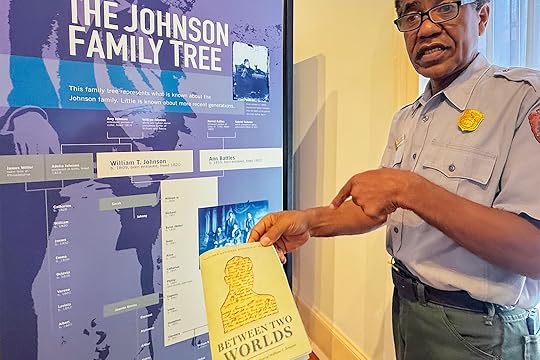
Photo: Jackie Sheckler Finch
When I walked into the big brick William Johnson House, National Park Ranger Eric Howard was holding a book, Between Two Worlds. The true story, Howard said, best described the life of the man known as the “barber of Natchez.”
Born a slave in 1809, Johnson was emancipated at age 11 by his white slave owner, also named William Johnson and believed to be the boy’s father. Trained to be a barber by his sister’s husband, Johnson opened his first barber shop in Natchez in 1830. He would eventually own and operate three barbershops and a bathhouse in Natchez and became a slave master himself.
Although most people didn’t know it, Johnson also kept a diary covering 16 years of his life from 1835 until his death in 1851. He wrote about daily events and business accounts as well as town tales and local townsfolk. Becoming a successful and well-respected businessman, Johnson still walked a fine line between the full rights of a white citizen and a freed Black man. In early 1851, Johnson had some property he owned surveyed because a neighbor, Baylor Winn, was reportedly selling timber from the site.
On June 16, 1851, Winn ambushed Johnson and shot him in the back. Johnson died the next morning, but not before he identified his murderer. Winn was arrested but eventually set free. As for Johnson’s diaries, for more than 75 years, they sat inside a trunk in the attic of his Greek Revival townhouse. Finally, Louisiana State University bought the diaries in 1938 and published them in 1951, giving a rare glimpse into the life of a free person of color in his own words.
The Johnson home is now a museum and displays copies of his diary as well as some of the family’s original pieces of furniture, including an ornate Rococo Revival carved and gilded mirror that once stood in Johnson’s barbershop and home. Johnson and his wife Ann and their 10 children lived upstairs in what is now the museum. The downstairs was used for commercial enterprises. As has been said, Johnson was a smart businessman.
William Johnson House: 210 State St., Natchez, MS 39120
Natchez Museum of African American History and Culture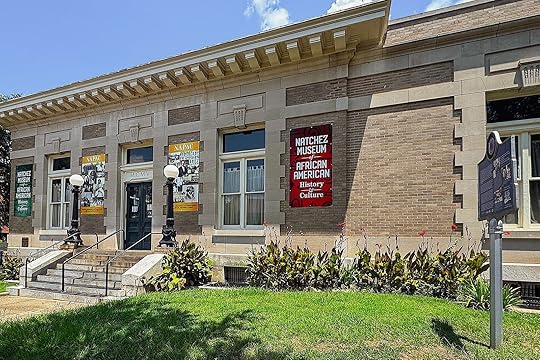
Photo: Jackie Sheckler Finch
Excitement reigned supreme. Chicago jazzman Walter Barnes and his dance orchestra were coming to town. On the night of April 23, 1940, an estimated 750 folks from the Natchez African American community gathered at the Rhythm Club on St. Catherine Street for the big event.
The large wooden building encased in corrugated iron was festooned with decorative Spanish moss hanging from the ceiling. The moss had been sprayed with Flit, a petroleum-based insecticide. To prevent gatecrashers, all exits but the front door were boarded.
The story goes that a man was smoking inside the club. Told to discard his cigarette, the man tossed it aside, setting the Spanish moss on fire. Suddenly, the Rhythm Club was a blazing inferno. Frantic patrons stormed the only door where victims were burned, suffocated, or crushed to death.
Bandleader Barnes was hailed as a hero for trying to calm the crowd while he and his band continued to play the song “Marie.” Barnes and nine of his band members perished in the fire that’s said to have claimed 209 identified victims. Many were buried in a mass grave in Watkins Street Cemetery.
A historical marker at the Natchez Museum of African American History and Culture details the event. Visit the museum to learn more about what was known as one of the deadliest fires in American history and that led to major revisions in fire safety protocol nationwide.
Natchez Museum of African American History and Culture: 301 Main St., Natchez, MS 39120
Where to eat and drink in Natchez Frankie’s on Main
Photo: Jackie Sheckler Finch
Formerly a bank, this restaurant has kept the bank look and serves food and craft cocktails. Diners can even choose to eat in the vault. Built in 1826, the Greek Revival-style building opened as a restaurant in 2023 and quickly became one of the city’s most popular dining spots.
The décor is bright and quirky and happy. The menu is diverse and so delightfully offbeat that I was having a difficult time narrowing down my dinner choice. How about the bao buns, steamed buns that taste slightly sweet and are filled with grilled pork belly or peppered brisket or shrimp? Maybe grilled redfish served over carrot puree topped with buttered crab?
When server Mattie brought my Coke and water, I asked her opinion and she definitely steered me right. I hadn’t even considered the bourbon salmon, bacon, lettuce, and tomato with sliced avocado on sourdough bread, served with fries. Scrumptious.
Frankie’s on Main: 422 Main St., Natchez, MS 39120
Biscuits & Blues
Photo: Jackie Sheckler Finch
With a slogan like “Hot Biscuits & Cool Blues,” you know this must be a happening place. I went for lunch on a weekday so no music (I was told live music was usually on the weekend).
I ordered the specialty biscuits with apricot butter and had an oyster po’boy with Cajun fries. It was quite good, including the fries considering I’m not a real spicy person. In fact, the fries that I had at Biscuits & Blues and at Frankie’s on Main are among the best I’ve ever had.
Biscuits & Blues’ décor is simple but comfy with a long wooden bar with curved back stools. The menu features Southern comfort food like gumbo, crawfish etouffee, red beans and rice, and crawfish and mushroom beignets.
Biscuits & Blues: 315 Main St., Natchez, MS 39120
Natchez Brewing Company
Photo: Jackie Sheckler Finch
Pizza and beer. Natchez Brewing Company offers a tasty combo served by a charming man named Daniel. Established in 2014, Natchez Brewing Company is proud of both its beer and its hometown. Just look at the company logo, a paddlewheel riverboat, or check out the company website. It has a history of Natchez steamboats from Natchez I to Natchez VIII, when they were launched, and what happened to them.
Lisa Miller is the company owner and founder. Her husband, Patrick Miller, is the brew master. He creates the recipes and the brews. I stopped by Natchez Brewing Company for dinner after a long touring day. I passed on the beer because I was driving, but I did savor some delicious pizza and one of the best Greek salads I’ve ever had — loaded with black and green olives and plenty of feta cheese, just the way I like it.
The menu also includes many other beer-friendly foods, like calzones, brats and franks, and a bunch of savory snacks like pretzels, kettle-cooked chips, and cheesy garlic bread.
Natchez Brewing Company: 207 High Street, Natchez, MS 39120
Bowie’s Rabbit Hole
Photo: Jackie Sheckler Finch
More than a restaurant or a bar, Bowie’s Rabbit Hole is an entertainment center. Rabbit Hole serves lunch and dinner along with plenty of beer and cocktails like the Off With Your Head cocktail — a delicious mix of vodka, rum, peach schnapps, triple sec, orange juice, pineapple juice, cranberry juice, and grenadine.
A game room features retro-arcade gems, darts, and air hockey. Live music usually rocks the place every Friday and Saturday night. A big bonus is the Rabbit Hole’s location: right across from the bluff and gazebo overlooking the Mississippi River — a perfect place to catch one of Natchez’s glorious sunsets.
Bowie’s Rabbit Hole: 100 Main St., Natchez, MS 39120
Where to stay in NatchezWeymouth Hall
Photo: Jackie Sheckler Finch
For my two-night stay, I checked into Weymouth Hall Bed & Breakfast, located only minutes from downtown Natchez. Sitting atop one of Natchez’s highest bluffs, Weymouth Hall rises high over the Mississippi River and brings a spellbinding panorama any time of day or night.
Built in the 1850s, the mansion was named for former owner John Weymouth. My room had period furniture including a big comfy four-poster bed, a private bathroom, a flat-screen TV with satellite channels, air conditioning, a mini-fridge, free WiFi, and a coffee maker in the hallway outside my room.
Weymouth Hall also has a large free parking lot and a lovely swimming pool. One of the things I most enjoyed? No noise. When I went to bed, I immediately fell asleep and slept soundly until the next morning. A gift for a tired traveler.
Weymouth Hall: 1 Cemetery Rd., Natchez, MS 39120
Monmouth Historic Inn & Gardens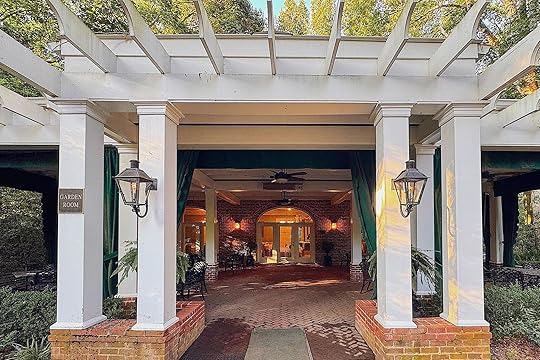
Photo: Jackie Sheckler Finch
In a nice arrangement, my breakfast the next morning was at Monmouth Historic Inn & Gardens a short drive away. Weymouth Hall gave me a voucher for a complimentary breakfast at Monmouth, so it was like getting to admire two historic homes in one.
Built in 1818 by postmaster John Hankinson, the Greek Revival Monmouth home was named after his home in Monmouth County, New Jersey. Set in 26 acres of manicured gardens, Monmouth has 30 rooms and suites. I didn’t tour the house but did walk through some of the glorious gardens on my way to the elegant Garden Room where breakfast was served.
In the Garden Room, a sideboard was filled with fruit, yogurt, pastries, and juice. Plus, I had a choice of two entrees: a Monmouth Southern Breakfast with two eggs cooked to my liking with grits, biscuit, and bacon or ham, or Ms. Mary’s Stuffed French Toast —deep fried French toast stuffed with cream cheese and served with bacon or ham. I chose the Southern Breakfast with bacon and was not disappointed.
Monmouth Historic Inn: 1358 John A. Quitman Blvd., Natchez, MS 39120
When to visit NatchezSpring and autumn are ideal times to visit the oldest city on the Mississippi River. Temperatures are not too hot, not too cold. Natchez in spring brings the annual Spring Pilgrimages in March and April. Since 1932, homeowners have opened the doors of their magnificent homes for public tours. Natchez has two garden clubs that offer historic home tours: the Natchez Garden Club and The Pilgrimage Garden Club. More than 30 homes were featured on the 2025 spring pilgrimage. Spring Pilgrimage guides often dress in historical clothing, including hoop skirts for women. Natchez also offers a Fall Pilgrimage in September and October.
In late September, fall foliage begins to arrive. While it’s impossible to predict the peak time to see colors along the Natchez Trace Parkway and in Natchez, generally mid-October to early November is the best time to see the most vibrant colors.
Getting to and around Natchez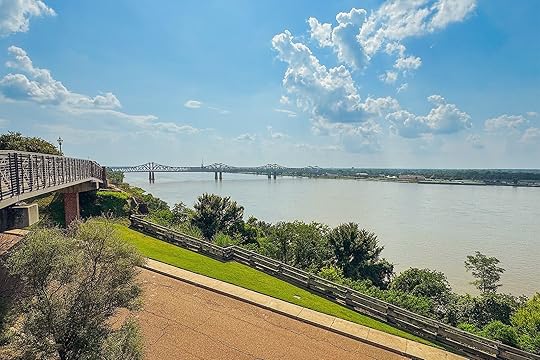
Photo: Jackie Sheckler Finch
For my August trip, I flew into Baton Rouge Metropolitan Airport (BTR) which is about a 90-minute drive to Natchez on the Natchez Trace Parkway. The airport is very small and clean with pleasant and helpful employees. A nice touch was several free books stands at the airport. The books were for all ages. In front of one book stand, I saw a happy youngster and his parents watching as he chose a colorful book about a dog’s adventures.
Driving from Baton Rouge was easy. Not much traffic. Mostly a straight scenic drive from the airport. Natchez is a very walkable city, and I had no problems finding parking spots when I was driving around Natchez.
For my ride, I picked up a rental car at the airport. I was traveling alone and wanted the freedom to see as much of Natchez as I could in my two days there. When I got my rental, the license plate made me smile as though I were getting a greeting, sort of a sign that this trip would be special. The letters on the license plate – WJF – were the initials of my late husband: William Joseph Finch.
Indeed, my Natchez visit was glorious. As street department worker Kenny noted when we went past his work site on my Open Air Tours, “We come into this world with nothing and we go out of this world with nothing. So it is important to enjoy the time that we have here.”
I most certainly did enjoy my time in Natchez. 
Horror film locations you can visit

If you’re looking for a spooky road trip this Halloween, what about a burger stop at the gas station from The Texas Chainsaw Massacre — now a horror-themed BBQ joint? Or you could spend the night in the Poltergeist house, which has been remade into an Airbnb. Across the US, you can climb the steps from The Exorcist, stroll the Santa Cruz boardwalk from Us, or visit the Rhode Island farmhouse that inspired The Conjuring. Some spots welcome overnight guests, while others are best admired from the curb — but all of them will send a shiver down your spine. So whether you’re a die-hard horror buff or just looking for a spooky detour on your next road trip, here are the filming locations you can actually visit.
We hope you love the Airbnb we recommend! Just so you know, Matador may collect a small commission from the links on this page if you decide to book a stay.
Jump to: Bonus international horror movie locationsElm Street house from A Nightmare on Elm Street
Photo: Elliott Cowand Jr/Shutterstock
It might be a little disheartening to learn that the house from A Nightmare on Elm Street isn’t actually on Elm Street, but finding out that the outside has been kept intact ever since filming should cheer up horror aficionados a bit. In the first movie, it belonged to Nancy Thompson and her family, then to Jesse Walsh in A Nightmare on Elm Street II: Freddy’s Revenge, and later served as Freddy’s dream house in subsequent films. Visiting here requires the same respect as other locations that are actual people’s homes, so be sure to take photos respectfully — without loitering or damaging the property.
Where: 1428 N Genesee Ave, Los Angeles, CA
The boardwalk from Us
Photo: Nick Fox/Shutterstock
Jordan Peele’s Us opens with a young girl who slips away from her parents at the Santa Cruz Beach Boardwalk and stumbles into a mirror-filled funhouse, where she comes face-to-face with her double. Years later, the Wilson family revisits the same seaside setting, and the terror begins again.
The boardwalk is California’s oldest seaside amusement park, which has been open since 1907, with rides like the Giant Dipper roller coaster and the Looff Carousel still in operation. Peele also included a nod to The Lost Boys (1987), another cult classic filmed here. Admission is free, and the rides and arcades operate seasonally, making it easy to see the filming location during an ordinary visit.
Where: Santa Cruz Beach Boardwalk, Santa Cruz, CA
The house from Poltergeist
Photo: Airbnb
In Poltergeist, the Freeling family’s sunny suburban home becomes the epicenter of paranormal chaos — from disappearing children to the infamous scene of skeletons rising from a backyard pool. While much of the interior action was filmed on soundstages, the exterior at 4267 Roxbury Street in Simi Valley is unmistakable.
For decades, fans could only drive by and snap a photo from the curb. But in 2024, new owner Rachel Powers poured $165,000 into transforming the four-bedroom home into a fully themed Airbnb. Inside, you’ll find era-specific props and staged rooms that recall the Freelings’ cursed household: a clown doll slumped in the corner, a vintage television humming with static, and a kitchen that still mirrors the film’s layout — now updated with modern appliances.
The 16,000-square-foot property sleeps up to eight and comes with a pool, spa, and fire pit. Rates start at $600 a night. And for those who like their scares “unscripted”, the house recently appeared on Ghost Adventures: Poltergeist Curse, where Zak Bagans reported flickering lights, cold spots, and objects moving on their own.
Where: 4267 Roxbury St, Simi Valley, CA
The town and woods from The Blair Witch Project
Photo:
Nicole Glass Photography/Shutterstock
Back in 1999, The Blair Witch Project terrified with its jittery camcorder realism, convincing many that the story of three students lost in the “Black Hills Forest” was a true account. Those opening shots of the trio driving into town were filmed in Burkittsville, Maryland — a place so small that the sudden rush of fans led to stolen town signs and more than a little local irritation.
While the movie suggests the woods are just beyond Burkittsville, the forest sequences were actually shot about 25 miles away at Seneca Creek State Park. Today, you can still walk the same trails the actors stumbled along, particularly near the moss-covered ruins of Black Rock Mill.
Burkittsville is still a quiet, close-knit town that never signed up to be a horror landmark, so it’s best to keep any stop there brief and respectful. Take a quick photo, then head to Seneca Creek for the real atmosphere. The park is open year-round, with miles of trails that darken fast under the trees. Keep walking, and it’s easy to see how audiences left the theater in ’99 convinced they’d just watched a documentary.
Where: Burkittsville, MD (town); Seneca Creek State Park, 16500 Black Rock Rd, Darnestown, MD
The farmhouse from The Conjuring
Photo: Katyplace/Shutterstock
Long before Hollywood got its hands on the story, the Arnold Estate in Harrisville, Rhode Island, was already infamous among paranormal circles. In the 1970s, the Perron family reported beds shaking, doors slamming, and the mother, Carolyn, supposedly levitating during a séance led by Ed and Lorraine Warren. Their decade in the farmhouse inspired James Wan’s 2013 The Conjuring, cementing the property as one of America’s most notorious haunted houses.
For years, owners of the house have opened the doors to brave visitors for day tours and overnight investigations, where guests could set up cameras in the cellar or try sleeping in the Perron girls’ bedrooms. While tours have currently been paused, the house is scheduled for auction on Halloween 2025, and its next owner will decide whether the doors stay open to the curious.
Where: 1677 Round Top Road, Harrisville, RI
Timberline Lodge from The Shining
Photo: Russ Heinl/Shutterstock
Stephen King published the novel The Shining in 1977. Just three years later, Stanley Kubrick produced and directed its screen adaptation. While it was mostly filmed in a studio, several exterior shots at the Overlook Hotel, where most of the film’s action takes place, were shot at the Timberline Lodge, though King’s inspiration for the Overlook is said to be the Stanley Hotel in Estes Park, Colorado. According to the Timberline, Kubrick was asked not to film scenes of room 217 (the room number used in the book, the movie’s is room 237) so that future visitors wouldn’t be afraid to stay there — but in a maybe not-so-unexpected twist, it’s the most requested room. Staying at the hotel from the Shining also affords visitors access to amazing to snowboarding, skiing, and hiking trails.
Where: 27500 E Timberline Road, Government Camp, OR
The lighthouse from The Fog
Photo: Gary Saxe/Shutterstock
John Carpenter’s second horror movie, The Fog, opened in 1980, just two years after Halloween. In it Stevie, a DJ, goes to a lighthouse to host her radio show after her son shows her a piece of wood that he found on a beach near the lighthouse. Eeriness ensues, and the lighthouse becomes a significant location where Stevie is able to see the fog closing in on the town. The lighthouse is Point Reyes Lighthouse in California, and fans are able to walk right up to the lighthouse and go inside. It’s a steep, 308-step walk down to the lighthouse, and it’ll almost always be covered in fog — making it seem almost as if you were in the movie yourself.
Where: Inverness, CA
The stairs from The Exorcist
Photo:
Eddie Peterson/Shutterstock
The Exorcist, filmed in 1973, is definitely a movie that’s gone down in cinematic history as one of the best in its genre. In the supernatural horror, a mother is living in Georgetown while working as an actress when her 12-year-old daughter becomes possessed by a demon after playing with a Ouija board. After taking her daughter to a number of doctors, Regan’s mother is recommended to perform an exorcism, and they meet Father Karras. These stairs are where part of the movie’s climax takes place; Karras confronts Regan’s demon and is then possessed by it. He sacrifices himself by jumping out of a window and falling down a myriad of stairs, taking the demon with him.
Where: On the corner of Prospect St NW & 36th St NW in Georgetown, Washington, DC
The gas station from The Texas Chainsaw Massacre
Photo: The Gas Station
The Texas Chainsaw Massacre saw many people complaining about the sheer amount of violence in the film and was banned from several countries from the get-go. However, it grossed over $30 million, surpassing its limited budget of under $200,000 tremendously. The gas station is one of the more infamous locations, though it initially seemed harmless. The group in the film stopped to get gas only to be told that there was none; they happen upon a house soon after where most of them are killed. One woman, Sally, manages to escape to the gas station, where she then is caught and tormented by the owner. The actual gas station had been abandoned for a while until it was turned into a horror-themed barbecue restaurant full of memorabilia called The Gas Station. And if you really want to have a fright fest, The Gas Station has converted space in the back of the station into cabins that guests can book a stay in.
Where: 1073 TX-304, Bastrop, TX
Crystal Lake Diner from Friday the 13th
Photo: Blairstown Diner
Regardless of whether or not people are horror movie fans, almost everyone has heard of Jason — the main antagonist and serial killer of the Friday the 13th franchise — or seen his iconic mask somewhere. The first movie came out in 1980 and is set in 1958 at newly refurbished Camp Crystal Lake, just a year after a boy drowned in the nearby lake. In the beginning of the movie, one of the camp counselors, Annie, heads into the Crystal Lake Diner to ask for directions to the camp. While Annie didn’t survive long after that, the diner where that scene was filmed still stands today and is open for business in New Jersey. Its real name is the Blairstown Diner, and every Friday the 13th fans flock to it in honor of the movie.
Where: 53 NJ-94, Blairstown, NJ
The library from It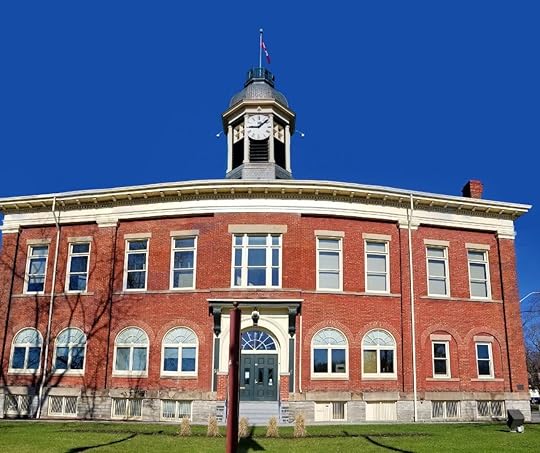
Photo: Municipality of Port Hope, Ontario
While It and its sequel, It: Chapter Two, take place in the fictional town of Derry, Maine, filming took place around Canada. The town of Port Hope, in particular, was taken over completely for filming and used for several important scenes and locations, as well as various exterior shots of Derry. One of the more significant settings is the Derry Public Library — it’s where young Ben writes a poem for Beverly and discovers the series of unexplained mysteries that have plagued the town, where he’s chased by Pennywise, and where adult Mike lives and shows Bill the origins of Pennywise, just to name a few scenes. While the library’s interior is a mix of shots from other locations, its exterior is that of Port Hope Town Hall. Within walking distance are other locations like Memorial Park, where the Paul Bunyan statue scenes take place; the street where the Losers ride their bikes and end up arguing; and the delivery door where young Mike is haunted by Pennywise.
Where: 56 Queen St, Port Hope, ON, Canada
The cemetery from Pet Sematary
Photo: Jon T. Powers/Shutterstock
Stephen King didn’t have to imagine a creepy burial ground — he lived near one. When Pet Sematary was filmed in 1989, several scenes were shot at Mount Hope Cemetery in Bangor, Maine, including King’s own cameo as a minister. The State Street side of the cemetery, with its steep hillside and old stone steps, served as the backdrop for some of the movie’s most memorable moments.
Mount Hope is still an active cemetery as well as one of Bangor’s oldest landmarks, so visits should be respectful. King fans often stop here as part of a broader Bangor tour, and the Historical Society occasionally offers guided walks that point out the filming locations.
Where: 1048 State St, Bangor, ME
The house from The Amityville Horror
Photo: John Arehart/Shutterstock
Few haunted houses are as instantly recognizable as the Amityville house on Long Island, with its Dutch Colonial shape and sinister “eye” windows peering from the attic. The 1979 film — and the best-selling book before it — turned the Lutz family’s alleged haunting into a pop culture phenomenon. By the mid-1980s, the address was changed from 112 Ocean Avenue to 108 in an effort to throw off relentless sightseers.
Today, the house remains a private residence. The original windows have been replaced, and renovations have softened its eerie aura, but fans continue to make pilgrimages, often standing across the street for a quick snapshot. Locals, however, are quick to discourage gawking and trespassing. If you do go, keep your visit brief and quiet — after all, the house may look ordinary now, but its reputation as “America’s most haunted home” ensures it will never quite escape its past.
Where: 112 Ocean Avenue, Amityville, NY
Michael Myers’ house from HalloweenView this post on InstagramA post shared by Michael Myers (@michaelmyers364) on Jul 31, 2018 at 8:08am PDT
Michael Myers is an iconic boogeyman character, right up there with the likes of Freddy Krueger and Jason Voorhees. He first appeared in John Carpenter’s Halloween in 1978, and the movie’s success paved the way for the series to flourish, turning it into an 11-film franchise. One of the more recognizable locations is the Myers house, where the film opens to him murdering his older sister and her brother. While it takes place in the fictional town of Haddonfield, Illinois, the house is actually located in Pasadena, California. The house is private property, home to the Alegria Chiropractic Center, so fans aren’t able to walk the property unless they’re being seen by one of Alegria’s doctors. That said, a pretty good view of the house can be seen from just across the street.
Where: North of 1000 Mission St, South Pasadena, CA
Palazzo Vecchio from Hannibal
Photo: Spirit Stock/Shutterstock
If you’re a fan of the cannibal serial killer’s story and have been looking for a push to visit Italy, look no further. Florence’s Piazza della Signoria is famous for a number of reasons: It’s one of the most highly trafficked plazas in the city and home to the copy of Michelangelo’s David statue, the Loggia dei Lanzi with its wide arches on top of Corinthian-style columns, and the marble Fountain of Neptune. The Romanesque Palazzo Vecchio also finds its home in the plaza and is the city’s town hall. In Ridley Scott’s Hannibal (2001), the fortress is used as the setting for one of the more gruesome murders in the movie.
One of the plotlines in the film is Rinaldo Pazzi, Chief Inspector, investigating the disappearance of a library curator. During his search, he talks to who he thinks is Doctor Fell, the library’s assistant curator, but is actually Hannibal pretending to be Fell. When Pazzi learns of the bounty on Lecter’s capture, he becomes enraptured by greed and tries to capture the killer himself. Lecter baits Pazzi into a room in the Palazzo Vecchio, ties him up, cuts out some of his gastrointestinal organs, then hangs him over a balcony — right next to some of the plaza’s famous statues.
Where: Piazza della Signoria, 50122 Firenze Florence, Italy
Dr. Frank N. Furter’s mansion from The Rocky Horror Picture Show
Photo: SimonWest/Shutterstock
Those who have seen The Rocky Horror Picture Show will never forget it, and those who haven’t can’t stop hearing about it — and for good reason. What began as an unemployed-at-the-time actor’s project to keep busy turned into a stage production and then into the 1975 science-fiction, horror-comedy musical we all know and love. It was shot in England at Bram Studios and on location at the Oakley Court Hotel. Fans may recognize Oakley Court as the mansion of the enigmatic Dr. Frank N. Furter, where central characters Brad and Janet find themselves after their car breaks down in the rain. During filming, it was an empty estate with no working utilities, but it has now been turned into a fully functioning hotel. Many of the original structures from the film remain. There are 118 guest rooms, all designed in typical country-British fashion; a spa; swimming pool; tennis courts; a croquet lawn; a golf course; and boat and bike rentals. You’ll be able to live it up in the English countryside and have an easier time of it than Brad and Janet. 
Where: Windsor Rd, Water Oakley, Windsor, UK
More like thisEntertainment8 Serial Killer Tours for the True-Crime ObsessedSeptember 8, 2025
Field-Tested in the Sierra Nevada: The Marmot Limelight 3P Makes Car Camping Extra Comfortable

If you’re a backpacker, you probably know that you usually have to sacrifice on one of three categories with outdoor gear: weight, size, or cost. And that’s true for tents. Ultralight tents that pack up into small packages usually cost a pretty penny, with far cheaper tents available — but they almost always take up more space and weigh more.
Fortunately, one of the nice things about car camping (camping where you can drive to your site) is that it doesn’t really matter how much your tent weighs, or how small it packs up. That means any tent will do — or so I thought.
I spent many years car camping with a relatively cheap tent. Actually, it was free: we found it on the ground while leaving Coachella in 2017. I later found out it came from Walmart and retailed for about $50. I thought it was fine until I tried a brand new tent from Marmot, and realized the right tent actually can make car camping way more pleasant.
After a few weekends of camping in the colorful Marmot Limelight Three-Person (3P) Tent, it’s clear it’s exactly what it promises to be: a mid-range, comfortable tent for car camping or close walk-in sites, with a few useful features that give it a leg up over comparable options. It’s a tent for campers who want their nights outside to be as comfortable and frustration-free as possible, with easy assembly, big doors for ventilation in fluctuating temperatures, and a smart design with space to stay organized.
Here’s what to know about the Marmot Limelight 3-Person, if you’re considering buying a new car camping tent.
We hope you love the gear we recommend! Just so you know, Matador may collect a small commission from the links on this page if you decide to make a purchase. Listed prices are accurate as of the time of publication.
Summary of our Marmot Limelight 3P testingCategory: TentsPrice: $359Trail weight: 5 lb, 15 oz.Best For: Car camping, festivals, walk-in campsitesBuy Now: $359Pros:
Roomy inside for two (tight but doable for three)Dual side vestibules to create dedicated space for each personEasy assembly thanks to color-coded materialsComes with matching tent footprintComfortable inside, even in temps ranging from 45 to 85 degrees FCons:
Tent zipper and rainfly zipper open on opposite sidesZipper flap fabric occasionally gets caught in the zipper
Set up and first impressions
 Photo: Suzie Dundas
Photo: Suzie Dundas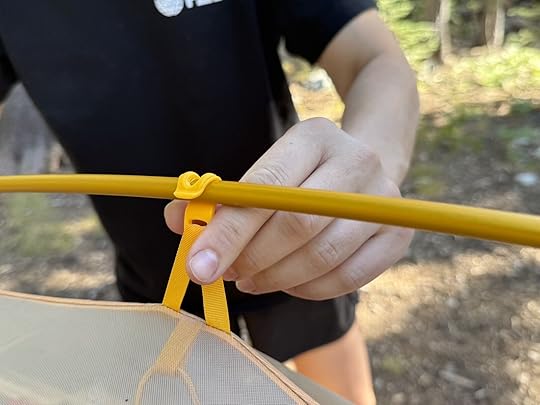 Photo: Suzie Dundas
Photo: Suzie Dundas Photo: Suzie Dundas
Photo: Suzie DundasOut of the package, the Marmot Limelight 3P feels like any other tent, though it does come with a footprint (something you usually have to buy separately). The poles come in their own bag, as do the stakes, making it easy to keep everything organized.
I went through a range of emotions setting up the Limelight 3P. It seemed confusing at first, partially because the tent has a triangle-shaped internal vestibule on each side. When lying flat, those vestibules flop to the sides, giving the tent a “T” shape when viewed from above, rather than a rectangle. I spent a few minutes trying to make sure I had it lined up correctly on the gray fabric footprint until I noticed something obvious: the tent and rainfly are color-coded. The blue poles and clips line up with the blue loops, while yellow poles and clips line up with yellow loops. This also made setting up the rainfly quite simple and quick, despite the fact that the dual oversized doors can make it tricky to tell what part of the tent is what when you first unfold it, especially if they’re unzipped.

The bent tent poles create extra living room inside, but take up a touch more space when packed. Photo: Suzie Dundas
But as soon as I realized it was color-coded, things became much easier. It took under five minutes to set up once I knew what I was doing. One person can set it up no problem, but with two people, you’re probably looking at more like a two-minute assembly time. Otherwise, setup is like any other tent, with bungee cords that snap together to build the frame, and clips that attach the tent to the poles.
The Marmot Limelight 3P is almost entirely freestanding, as the tent and rainfly are pole-supported, but each vestibule requires one stake. If you’re on a surface where you’re unable to use stakes, just put something heavier on the inside of the vestibules, and they’ll more or less work the same way (though they may flap a bit in heavy wind). The rainfly door attaches to the same stake, so expect the door to flap a bit if you can’t use stakes. However, the rainfly doors each have a small loop on top to keep them rolled up and open, if the flapping gets annoying.
Weight and packability
The Marmot Limelight 3P packed up. Photo: Suzie Dundas
The Limelight 3P lands in the middle of the pack on size and packability. Of course, these are considerations that matter more when backpacking. The curved poles take up a little more space than straight poles, and it packs into a 24-inch-long bag with a 6.5-inch diameter. It weighs 7 pounds, 2 ounces when packed, or about six pounds with just the essentials. That’s almost exactly the same weight as the beloved REI Half Dome 3P (7 pounds, 2.5 ounces), and heavier than the Big Agnes Copper Spur UL 3P (3 pounds, 13 ounces, but that one costs $200 more).
For car camping, we found the size and weight minimally important. That said, it’s still relatively light, and could be used for walk-in campsites, especially if you divide the weight between two hikers. Many non-technical tents, like the old one I had from Walmart, are bulkier and can weigh in well over 10 pounds, which is a bit too much to lug to a campsite that requires any amount of walking.
Durability and materials

The poles are lightweight aluminum, not carbon. Photo: Suzie Dundas
Though the Limelight 3P is about the same packed size and weight as comparable tents, it’s made with more durable materials. This means it’s more likely to withstand wear, tears, rips, and abrasion. The floor is made from 68D polyester taffeta, making it thicker than floor fabric on comparable tents like the REI Half Dome 3P (40D ripstop nylon) and the Big Agnes Copper Spur 3P (20D ripstop nylon). Add in the fact that it comes with a 68-denier polyester footprint to put under the tent, and you suddenly have a super-durable combo that resists damage, even on rocky, rough ground covered in pointy acorns and sharp rocks. The rainfly is thicker than many comparable options, and is the same material you’ll find on tents from brands like Kelty, MSR, and Coleman.
A key difference in materials between the Limelight 3P and higher end backpacking tents is that the Limelight uses aluminum for the poles, not carbon. It’s less expensive, but weighs a bit more. If you’re looking for an ultralight backpacking tent, you’ll want to check out the Limelight UL (ultralight) version.

Inside the Limelight, with plenty of space for two people to spread out. Photo: Suzie Dundas
The Limelight 3P is just the right size for two campers who want extra room to spread out. For car camping, my husband and I each have a 30-inch-wide self-inflating pad, so our tent needs to be at least 60 inches wide. The Limelight is 65 inches across, easily fitting our pads side-by-side. The pre-bent poles and steep sidewalls turned the interior from a cramped pyramid into a comfortable dome-shaped space, allowing us to sit up side-by-side without leaning into the tent walls. This is especially important for cold-weather camping, as touching the sides of the tent can make condensation drip onto your sleeping bags and sleeping pad.
The Limelight is a three-person tent, and three people would probably be able to sit side-by-side, but you’d be touching hips. When it comes to sleeping, the person in the middle would have to put his or her head at the other side of the tent. It’d be tight, but possible with mummy-style camp pads, and the layout would mean no one had their face directly next to another person.
Another feature that makes the tent quite livable are the dual doors, with one on each side of the tent. This allows each person to easily exit, avoiding the dreaded middle-of-the-night wakeup when one person has to climb over the other to go pee in the woods.

The tent’s top half is all fine, bug-proof mesh. Photo: Suzie Dundas
I run cold, so I didn’t get warm in the tent at all, even sitting in it for brief periods during the middle of the afternoon. However, I see where someone could get a little warm, as the rainfly has no vents, mesh, or flaps. However, the vestibules between the mesh door and the rainfly’s sides are quite large, providing decent airflow and eliminating any condensation on 40-something degree nights. But if you like having a strong breeze, you’ll need to either skip the rainfly entirely, or sleep with the rainfly rolled up over both doors to create cross-ventilation.
During our testing, we never got cold, even when the temperature dropped into the 40s. We also didn’t notice any condensation, even with cool temps outside and our body heat inside. That’s not the case with our cheap tent from Walmart, which always felt like it was letting drafts and cool air in through the seams.
We had clear skies during our testing weekends, so we had to simulate rain by spraying a garden hose on the tent when we got home. It performed as well as we’d expect a brand-new tent to perform. While the inside of the tent felt a little clammy with water on the outside, it was still very much dry, and you could see water beading off and rolling down. And the included footprint can be used strategically in rain to direct water around the tent, rather than under it. Our expectation is that this level of water resistance would continue, provided the tent is cared for properly (for example, not left out in the sun for weeks on end).
For most people, it should be waterproof enough for any conditions you’d want to camp in. However, it’s designed to be a three-season tent, so we’d recommend something more technical (and likely more expensive) for winter and snow camping, or camping in extreme conditions.

Photo: Suzie Dundas
Easy-peasy (once you figure out the color-coded thing). The only catch is that you need to put it away properly for it to fit in the bag. This is easy: lay the tent, rainfly, and footprint on top of one another; fold them into thirds, then roll them up around the poles like a sleeping bag.
My favorite feature: dual inside vestibules
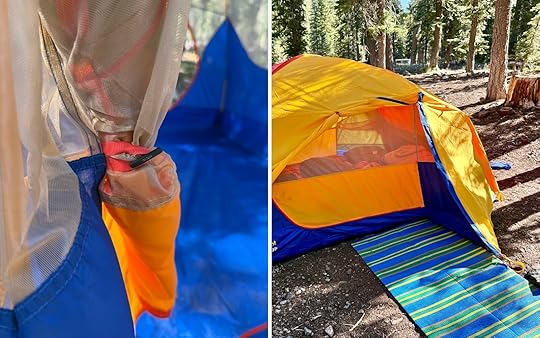
The inside vestibules (right) create dedicated space for each person, while the hook-and-loop system (left) keeps the doors rolled up and out of the way when needed. Photo: Suzie Dundas
The Limelight 3P has one useful feature we really liked: a small inside vestibule on each side, giving each person in the tent space to keep his or her items handy and organized. With smaller tents, I often find myself searching around in the dark at night for things like my Kindle, socks, or phone. But with the dual vestibules, each person has a private spot to keep items where they won’t get it anyone else’s way and won’t get lost under sleeping bags and pillows.
A few other features that were immediately useful include multiple hanging inside pockets for smaller items like headlamps, and a light diffuser pocket at the very top. The opaque fabric softens light, turning a headlamp into a tent ceiling light. We also appreciated the hooks to keep the rainfly and tent doors rolled up and out of the way.

The tent door and rainfly zippers open in opposite directions. Photo: Suzie Dundas
Our main gripe with the Limelight 3P is that the tent doors unzip in the opposite direction of the rainfly zippers. In practice, this means you have to unzip the tent door entirely to use the rainfly zipper. Sometimes, brands do that so that any rain or wind that comes through the rainfly zipper doesn’t hit directly into the tent door zipper. But since the tent door is mesh on top, I’m not sure why it’s designed this way. It’s a small annoyance, and many people may not even notice it.
A secondary gripe, if we’re being picky, is that the fabric flap covering the rainfly zipper got caught several times in the actual zipper, especially when we were in a hurry. A little jiggling or a quick pull remedies the issue, and it’s something we’ve noticed on backpacking bags and sleeping bags, too. However, it’s an understandable design choice: flaps are an inexpensive way to add water resistance to a zipper, instead of using a bulkier YKK waterproof zipper.
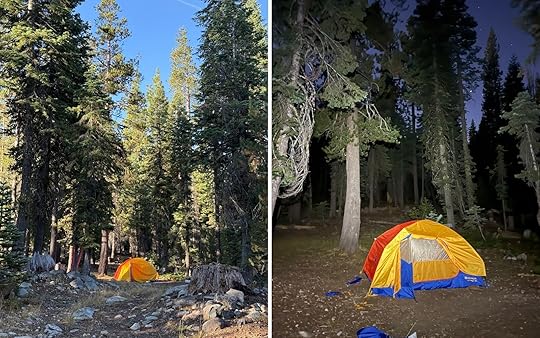
With nearly neon colors, you’ll never have trouble finding your tent. Photo: Suzie Dundas
If you usually camp in muddy or wet conditions, the MSR Elixir 3P may be a better choice. That’s because the tent floor is 70D nylon with a 3,000mm waterproof rating, so it’s less likely to absorb moisture in extended rainy conditions (but does not include a footprint). The Elixir sleeps three people side-by-side, rather than putting the middle person at the opposite end.
The Big Agnes Copper Spur UL3 is both lighter (at four pounds) and packs up smaller. But it has the thinnest materials and the lightest waterproof rating, so you’ll need to choose your site more carefully in rainy conditions, and it may not stay quite as dry on the bottom if there’s rain and water running around your tent for hours on end.
If you’re an REI shopper, the REI Half Dome 3P is a viable alternative to the Limelight 3P. The floor has just a touch more waterproofing than the Limelight floor, but the materials are a bit thinner, making them potentially more susceptible to damage. It’s also a smidge pricier, at $399.
If you like the size and vestibules on the Limelight 3P, but are looking for a tent better suited to backpacking, the Limelight UL (Ultralight) 3P tent could be a better choice, weighing in at 3.5 pounds with aluminum poles. It packs to a 20-inch-long, seven-inch diameter package, though it’s usually advisable to divide tent weight between hikers, rather than carrying it in its original bag. The weight savings also comes at a premium, with the Limelight UL 3P tent retailing for $549 — roughly $200 more than the non-ultralight version I tested. It does not include a footprint.

Photo: Suzie Dundas
The Marmot Limelight 3P is an ideal car camping tent for two people, with plenty of room to move and useful dual inside vestibules.Curved tent poles make the packed size a bit larger, but create a roomy interior that feels less like a pyramid and more like a dome.Setup was easier than expected, and dual doors mean middle-of-the-night breaks won’t wake everyone in the tent.The lack of mesh on the rainfly could make the interior warm if you’re camping in extremely hot conditions.While it’s relatively light for a car camping tent, at six pounds, we’d recommend the ultralight version to backpackers.Buy Now: $359More like thisTravelThe Gear Matador Editors Love For Spring HikesHow we tested:
About our tester: Suzie is Matador Network’s commissioning editor and a happy camper, having camped everywhere from Alaska and Colorado to Chile and Vietnam. She’s used and tested backpacking tents from brands like Fjällräven, Sierra Designs, The North Face, and MSR, in conditions ranging from 90-degree heat to heavy snow. She’s been reviewing outdoor gear for multiple publications for years and has a strong understanding of technical materials, features, and what does and doesn’t matter in the Great Outdoors.She field tested this in the Sierra Nevada, at remote drive-in campgrounds. It was dry and dusty, yet also full of mosquitoes, with temperatures in the high 40s at night and low 90s during the day.
Matador Network's Blog
- Matador Network's profile
- 6 followers



